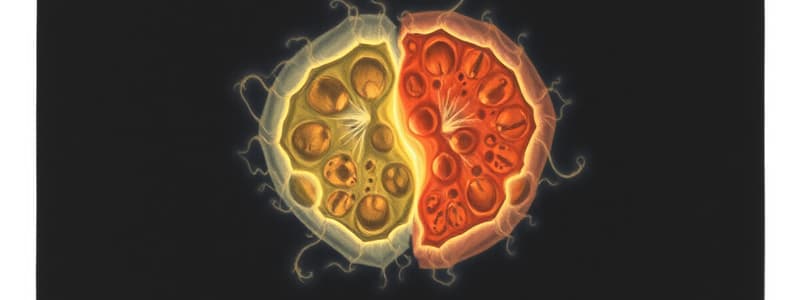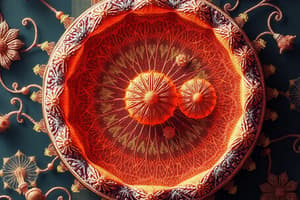Podcast
Questions and Answers
What is the main outcome of the cell cycle?
What is the main outcome of the cell cycle?
- Production of two daughter cells (correct)
- Synthesis of DNA only
- Formation of a single daughter cell
- Replication of organelles only
Which processes must occur in a coordinated way during cell division?
Which processes must occur in a coordinated way during cell division?
- Energy production and organelle duplication
- Protein synthesis and cell growth
- Cell division, DNA replication, and cell growth (correct)
- DNA replication and cytoplasm division
How do newly formed daughter cells contribute to the growth of an organism?
How do newly formed daughter cells contribute to the growth of an organism?
- By combining their DNA with parental cells
- By dying shortly after division
- By themselves repeating cycles of growth and division (correct)
- By undergoing direct cell fusion
What does the cell cycle include besides cell division?
What does the cell cycle include besides cell division?
What term describes the sequence of events through which a cell duplicates its genome and divides?
What term describes the sequence of events through which a cell duplicates its genome and divides?
What occurs during the G1 phase of the interphase?
What occurs during the G1 phase of the interphase?
If the initial amount of DNA per cell is 2C, what will it be after the S phase?
If the initial amount of DNA per cell is 2C, what will it be after the S phase?
What occurs during the G2 phase of interphase?
What occurs during the G2 phase of interphase?
In animal cells, which structure duplicates during the S phase?
In animal cells, which structure duplicates during the S phase?
Which of these statements is true regarding chromosome number after the S phase?
Which of these statements is true regarding chromosome number after the S phase?
What is the primary purpose of cytokinesis in cell division?
What is the primary purpose of cytokinesis in cell division?
How does cytokinesis differ in animal cells compared to plant cells?
How does cytokinesis differ in animal cells compared to plant cells?
What structure forms in plant cells during cytokinesis?
What structure forms in plant cells during cytokinesis?
In what scenario might karyokinesis occur without cytokinesis?
In what scenario might karyokinesis occur without cytokinesis?
What is the primary role of the cell-plate during plant cell cytokinesis?
What is the primary role of the cell-plate during plant cell cytokinesis?
What occurs during the leptotene stage of Prophase I in meiosis?
What occurs during the leptotene stage of Prophase I in meiosis?
What is a bivalent in the context of meiosis?
What is a bivalent in the context of meiosis?
Which phase of meiosis I involves the pairing of homologous chromosomes?
Which phase of meiosis I involves the pairing of homologous chromosomes?
What structure is formed during the zygotene stage of Prophase I?
What structure is formed during the zygotene stage of Prophase I?
How many haploid cells are produced at the end of meiosis II?
How many haploid cells are produced at the end of meiosis II?
What is the primary event occurring during the pachytene stage of prophase I?
What is the primary event occurring during the pachytene stage of prophase I?
What characterizes the beginning of the diplotene stage?
What characterizes the beginning of the diplotene stage?
What is the role of the enzyme recombinase during crossing over?
What is the role of the enzyme recombinase during crossing over?
What happens by the end of diakinesis?
What happens by the end of diakinesis?
Which structures represent the sites where crossing over occurs?
Which structures represent the sites where crossing over occurs?
Flashcards are hidden until you start studying
Study Notes
Cell Cycle Overview
- All organisms originate from a single cell through processes of growth and reproduction.
- Cell division results in two daughter cells from a parental cell, contributing to the formation of large organisms from a solitary cell.
- The cell cycle encompasses DNA replication, cell growth, and division in a coordinated manner to ensure intact genome distribution to daughter cells.
Phases of the Cell Cycle
- Interphase consists of three phases:
- G1 Phase (Gap 1): Active metabolism and growth without DNA replication.
- S Phase (Synthesis): DNA replication occurs, doubling the amount of DNA from 2C to 4C while chromosome number (2n) remains unchanged.
- G2 Phase (Gap 2): Protein synthesis and further cell growth preparing for mitosis.
M Phase
- Mitosis involves two main processes:
- Karyokinesis: Segregation of duplicated chromosomes into daughter nuclei.
- Cytokinesis: Division of the cytoplasm into two separate daughter cells.
- In animal cells, cytokinesis occurs through the formation of a furrow that deepens to split the cell.
- In plant cells, cytokinesis involves the formation of a cell plate, expanding outward to meet existing cell walls.
Importance of Mitosis
- Essential for growth, tissue repair, and reproduction in organisms.
- Mitosis ensures that each daughter cell receives an identical set of chromosomes.
Meiosis Overview
- Initiated after DNA replication to produce sister chromatids.
- Meiosis consists of two divisions:
- Meiosis I: Homologous chromosomes pair up and recombination occurs.
- Meiosis II: Similar to mitosis, leading to the separation of sister chromatids.
Phases of Meiosis I
- Prophase I is longer and complex, divided into five phases:
- Leptotene: Chromosomes become visible and compact.
- Zygotene: Chromosomes begin synapsis, forming homologous pairs (bivalents).
- Pachytene: Characterized by distinct tetrads and the formation of recombination nodules; crossing over occurs, leading to genetic recombination via the enzyme recombinase.
- Diplotene: Homologous chromosomes separate except at chiasmata where crossing over occurred; this stage can last long in oocytes of some vertebrates.
- Diakinesis: Chromosomes condense completely, the nuclear envelope breaks down, signaling transition to metaphase.
Metaphase I
- Bivalent chromosomes align on the equatorial plate, with spindle microtubules attaching to the kinetochores of each homologous chromosome.
Conclusion
- Both mitosis and meiosis are critical processes in the life cycle of cells, contributing to growth, reproduction, and genetic diversity.
Studying That Suits You
Use AI to generate personalized quizzes and flashcards to suit your learning preferences.




